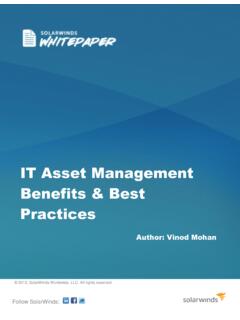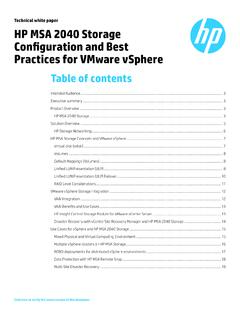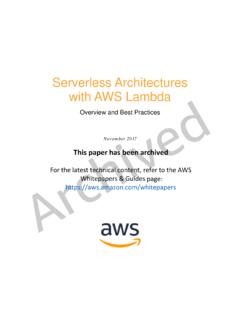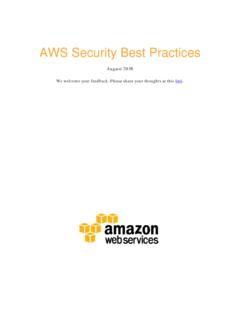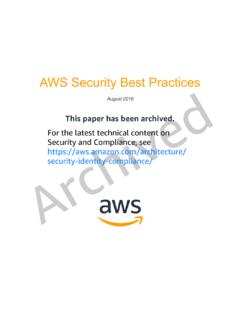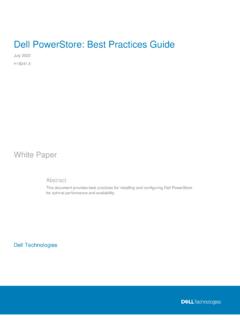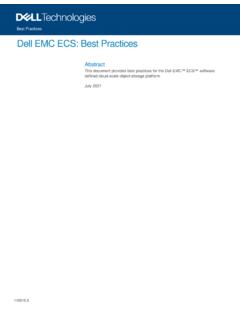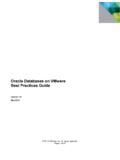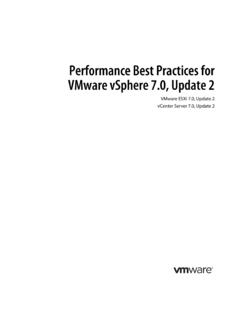Transcription of IT Asset Management Benefits & Best Practices
1 IT Asset Management Benefits & best Practices Author: Vinod Mohan 2013, SolarWinds Worldwide, LLC. All rights reserved. Follow SolarWinds: Introduction The fact that your IT infrastructure is growing is undisputed; and you know it! Each day new users are being added and so are IT assets hardware and software. It's the responsibility of system admins to track and manage these assets. Potential IT issues could be resolved quickly, efficiently, and with better IT administration support, if you have the visibility into all the IT assets that exist in the organizational IT landscape network, data center, remote sites, user workstations, etc. What is IT Asset Management ? IT Asset Management (ITAM) is a set of business Practices that join financial, contractual, and inventory functions to support life cycle Management and strategic decision making for the IT environment [1].
2 Managing IT assets allows you to get maximum value from the use of the assets, right-size IT inventory, and optimize inventory purchase decisions and strategies. IT Asset Management provides you the means to achieve complete visibility into your IT infrastructure inventory, helping you gain an in-depth understanding of: What systems and equipment exist Where components reside How they are used What they cost When were they added to the inventory Whether they have an expiry date How they impact IT and business services This level of visibility into Asset details will help organizations improve infrastructure efficiency and performance, and minimize related overhead expenses. All organizations, in one way or the other, perform ITAM. It's important to implement ITAM Practices intelligently, in order to achieve IT operational efficiency, financial accountability of Asset purchase, simpler auditing and compliance, and long-term Asset manageability and maintenance.
3 In this white paper, we'll focus on the Benefits of proper IT Asset Management , best Practices , and how to implement it, so it Benefits your IT teams, business, end-users and employees. IT Asset Management Methodology The major goal of ITAM is to establish a centralized Asset repository that accounts for the presence and purchase of all your hardware and software inventory. To achieve this, ITAM methodology comprises the following steps: Follow SolarWinds: 2. Asset discovery, data capture and storage Discovering all hardware and software components of IT. inventory on the IT infrastructure and capturing their details, such as the type of Asset , make, specification, etc., and storing it in an Asset repository Asset tracking Being able to identify and track change in the location of assets, increase or decrease the number of assets, track assignment status and user information Asset lifecycle Management Being able to capture the Asset lifecycle data right from requisitioning, purchase and assignment, to expiry and decommissioning Asset reporting and alerting Being able to generate Asset inventory reporting, and receive alerts on Asset warranty and lease expiration Centralized organization-wide ITAM process and Asset repository will also help you support various ITIL functions, such as configuration Management , incident Management , problem Management , and service level Management .
4 While we are looking to build a centralized Asset repository, it's important to understand the difference between Asset repository and configuration Management database (CMDB). The CMDB is an evolution of the Asset repository which is part of the ITIL framework. Beyond the scope of Asset discovery and tracking, the CMDB is integrated with service desk functions and is part of IT service Management and change Management . Hardware Asset Management Hardware Asset Management is the process of tracking and managing the physical components of computers and computer networks, from acquisition through disposal. The goals of hardware Asset Management are to account for all hardware assets on the IT infrastructure to provide comprehensive inventory visibility. Further, to help with vendor contract and lease Management , and to assist in making budgetary forecasts based on the stock of assets and business requirement.
5 Software Asset Management Software Asset Management is similar to hardware Asset Management , but focuses on software assets, including licenses, versions, and installed endpoints. ITIL states that the goals of software Asset Management are to reduce IT. costs and limit business, legal and security risks related to the ownership and use of computer software, while maximizing IT responsiveness and end-user productivity Let's dive a little deeper and understand the various Benefits of IT Asset Management and some best Practices to implement it in your IT framework. Follow SolarWinds: 3. Benefits of IT Asset Management Gain Control Over IT Inventory If you are carrying out an effective Asset Management practice for your organization, you'd benefit from deeper visibility into your hardware and software assets.
6 Therefore, IT Admins and support personnel should look further into viewing and managing Asset details of the end-user system. Asset Management gives you the ability to easily view the hardware and software components of a computer, server, or any other network infrastructure. Traceability of assets across your IT landscape gives you better IT administration control and accountability. Using an automated Asset discovery and Management functionality, along with your server and application monitoring tool will allow you to see the computer inventory details, all while you are actually troubleshooting a server crash or application performance issue. You can also find out if an employee has any unauthorized and non-compliant hardware or software on their enterprise workstation. A server or a workstation will benefit from Asset Management data covering the following: Drivers Out of Band Management Firmware Peripherals Graphics and Audio Ports and USB Controllers Hard Drives Processors Hosted Virtual Machines Removable Media Logical Volumes Software Inventory Memory storage Controllers Network Interfaces System Information Operating System Updates Applied OS Update Information Asset Lifecycle Management Hardware or software, there's bound to be a disposal or replacement date.
7 Asset Management allows you to keep track of when a hardware is purchased, how long has it been used, whether there's a lease expiring on the component, etc. For system administrators, it's important to know what version of software and how long your end-users have been running this software on their system, and whether their OS is current. This is actionable data IT teams utilize to decide if they should replace an old or faulty hardware, uninstall or patch a vulnerable application, or update the firmware on the system. Vendor contract Management should familiarize themselves with Asset information. In turn, they will know when to extend or renew a contract with your vendor or Follow SolarWinds: 4. hardware/software provider based on contract, purchase order, and expiry information fed into the Asset Management system.
8 Strategic Inventory Planning & Procurement Forecast When you keep track of what inventory you have in your IT infrastructure, it becomes easier to plan for future spending on assets. Without knowing what currently exists in your end-user systems both hardware and software it is very difficult to plan on procurement budget. You may actually end up procuring more assets, and those of which that are not required. Centralized and streamlined Asset Management lets you scan your entire network and list which hardware and software your system is using. Being able to collectively view inventory data with storage capacity of end-user systems is useful for storage utilization analysis and budget planning. This information becomes critical as you start charting out your financial planning, allowing you to plan well in advance for future Asset needs, and maximizing existing Asset utilization and eliminate unnecessary expenditure.
9 Increased Accountability to Ensure Compliance Keeping track of your IT inventory and automatically updating it using Asset Management systems will help you monitor hardware and software components of your network computers, and identify whether unapproved or harmful software or hardware is installed. Ensuring compliance with corporate security policies and desktop standards is a must for organizations, and efficient Asset Management of IT inventory will help you accomplish that. By allowing system administrators to quickly isolate vulnerabilities, such as illegal/unauthorized software, outdated software, games and unauthorized/malicious downloads, ITAM system makes it easier to see where potential risks may exist, so they can be prevented before major problems arise. Not just helping you to keep systems and assets compliant, but a good ITAM solution will also provide IT inventory reports for compliance auditing.
10 Automated Asset Discovery & Tracking Many companies manage their IT Asset inventory using manual, paper-intensive processes, which drain resources and are highly prone to inaccuracies and inconsistencies. Spreadsheets are used by many IT teams to manually enter details of the assets and then they constantly have to modify assets as they update. With the introduction of IT Asset Management solutions and Asset Management integrations with systems and network monitoring tools, this process has been made amazingly simpler and quicker. Follow SolarWinds: 5. ITAM systems perform automated device discovery on your enterprise LAN. For example, if there are Windows . servers and operating systems on your network, then using WMI, the ITAM tool can discover the Windows nodes and fetch all hardware and software Asset information from them.
